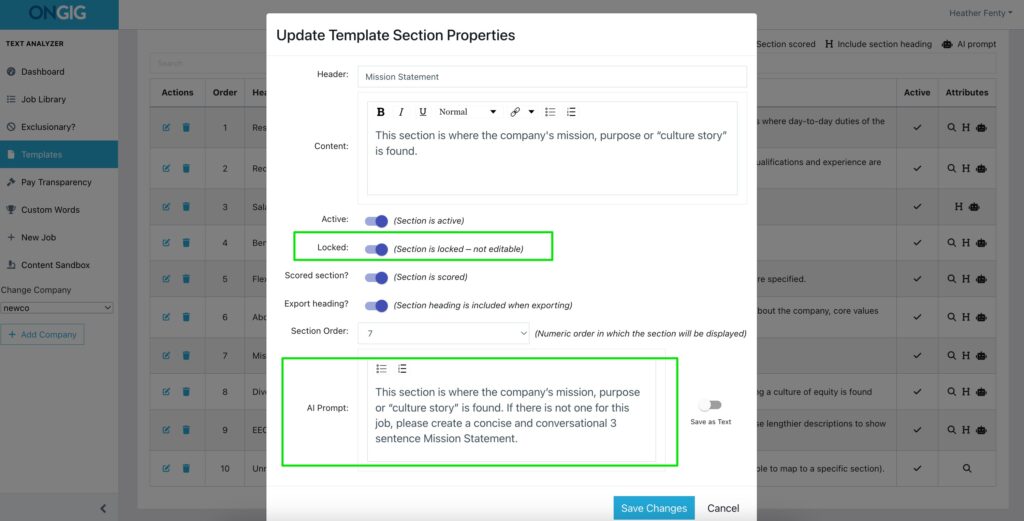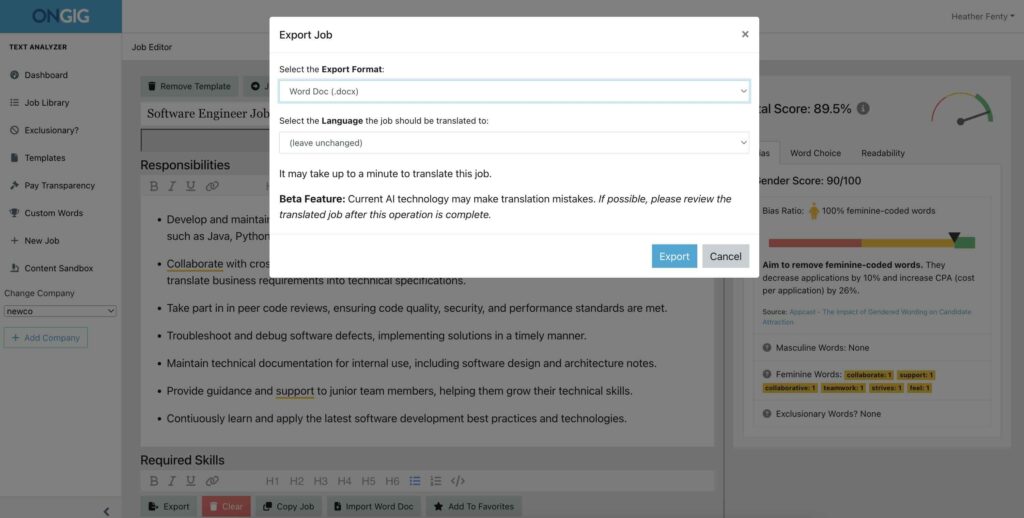- The Ultimate Guide to Job Description Templates + Helpful FAQs - April 22, 2025
- Why RoleMapper Is Changing the Way We Write Job Descriptions - April 16, 2025
- 100+ Famous Inclusive Leaders Who Helped Shape the Workplace - March 28, 2025
Writing job descriptions and job postings can be a daunting and time-consuming process, especially if you have to do it repeatedly for different open roles. With Ongig Text Analyzer, you can automate through smart templating and streamline your workflow.
Here’s a step-by-step guide to help you use Ongig Text Analyzer to save time and create effective job postings. You can also check out the video version here.
How to Use Ongig Text Analyzer for Automated Smart Templating for Your Job Descriptions
Step 1: Set Up Your Job Description Templates
Before diving into the automation process, you can set up your job description templates. You can create new templates or upload existing ones to the Ongig platform.
Ongig allows you to save multiple templates for different roles (departments or locations), so whether you’re recruiting for an open position or a variety of roles, you can easily apply the correct template to each job post. Custom templates will ensure that each job description fits your company’s approved language and structure.
Step 2: Upload the Job Description
Once you have the template ready, it’s time to upload a job description to Ongig’s Text Analyzer. Simply copy and paste your position description into the system (or upload it from a Word document).
You can also type in the job title and have Text Analyzer generate a job description in the editor with just a few clicks.
Note: For proffesional+ tiers, you can bulk upload your job description content through ATS integrations.
Your job description might include details about the job title, responsibilities of the position, salary range, essential job duties, performance benchmarks, and job requirements like years of experience or educational qualifications. Having this information ready helps Ongig know what sections to focus on.
Step 3: Apply a Smart Template to Your Job Descriptions and Job Postings
Now comes the magic—applying the smart template. Select the template you want to use for that particular job. Ongig will then work its AI-powered magic to automate the process.
For example, it will automatically reorganize sections such as responsibilities, job requirements, and salary range to match your custom template. This process helps keep your job descriptions consistent across all your open roles. This keeps things consistent and compliant.
Once you have solid, templated job descriptions, you can apply a specific “job posting” smart template to your job descriptions to convert them into more public-facing pieces of content. Think diversity statements, perks and benefits, mission statements, and other details supporting your company culture and employer brand.
Note: Some companies use the terms job description vs. job posting interchangeably. If this is the case for your company, you may only need one “job posting template.” This is the great thing about the smart templates, they are totally customizable based on your needs and workflow.
Step 4: AI Enhancements for Bias and Readability
One of Ongig Text Analyzer’s most powerful features is its ability to reduce bias and improve readability.
The tool will automatically scan your job listings for biased language, such as masculine-coded words, which can alienate qualified candidates. It will also give you the option to replace those terms with more inclusive alternatives, making your job post appealing to a broader audience of potential candidates.
And, you can choose to shorten long sentences to make your job description more readable. This ensures that your job advertisement captures the attention of candidates quickly and effectively.
Note: Ongig automates this step in the professional+ tiers, but you can click and swap words as needed in the basic tier.
Step 5: Review and Make Adjustments
While Ongig does a great job with automation, it’s important to review the changes the tool makes. AI isn’t perfect, so you’ll want to check that the key differences in the job descriptions and job postings still align with your company’s needs. Then, if necessary, move any sections that didn’t fit into the correct categories or delete outdated information.
And, if you have approved language like a mission statement or diversity and inclusion policy, you can lock those sections in place so they’re automatically applied across all your job posts. This feature ensures that your company culture shines through, regardless of who wrote the original description.

Even better, if your job postings are missing content for a section like “Mission Statement,” you can prompt the smart template to write one for you. Again, you’ll want to have a human check the output. AI is an assistant, but you still need to have the final sign-off.
Step 6: Finalize and Save
As you’re working and making edits, the tool saves your work automatically and stores it in the centralized job description repository. Once you’re happy with the results, you can export your finished job descriptions and job postings in multiple ways.
Click the “Export” button to find a dropdown with Word, PDF, and HTML options. There is also an option to export a translated Word document of your job descriptions and job postings. So, if you need a Spanish, French, or German version, you’ll choose from the Language dropdown.

Note: For premium+ tiers, you can sync the job content directly to your applicant tracking system.
Step 7: Post to Job Boards or Company Website
With your well-crafted job posting finalized, you’re ready to post it. Ongig helps you optimize your job content for search engines. This improves the chances that your job posts will rank higher on job boards and even on your company website. This also increases visibility among prospective talent and helps you attract the best candidates for the role.
By using Ongig’s automated smart templating, you can speed up your hiring process while ensuring that your job descriptions and job postings comply with federal laws, such as the Fair Labor Standards Act or pay transparency laws.
Monitor and Optimize Job Descriptions for Ongoing Success
Writing effective job postings is not a one-time task—it’s an ongoing process. Once your job posts are live, monitoring their performance and making adjustments as needed is important. This can significantly improve your ability to attract top talent and ensure your job advertisements resonate with the right candidates.
The Value of Tracking KPIs
One of the easiest ways to track the success of your job listings is by looking at key performance indicators (KPIs). These include the number of views the post receives and the click-through rate from job boards or your company website. They also include the number of applications submitted by prospective candidates. So, let’s say that a job post gets plenty of views but not many applications. That’s a sign that something in the post might discourage potential candidates from applying.
When evaluating job post-performance, consider adjusting specific elements, such as the job title, salary range, or minimum requirements. These components often have the biggest impact on how a job post performs.
For example, job titles that are too specific or too broad might not attract the right audience, while an unclear salary range might turn off qualified candidates. So, it’s a good idea to experiment with these variables and see what works best for different roles.
Also, pay attention to how your posts perform across various social media platforms and search engines. You can adjust your language and format for each platform to maximize visibility and engagement. So, for instance, shorter, punchier postings might work better on social media, while longer, more detailed descriptions might perform better on traditional job boards.
Don’t Skip SEO
Lastly, don’t forget about search engine optimization (SEO). Incorporating relevant keywords in your job posts can improve their visibility on search engines and help you attract more qualified candidates. If your job postings are optimized for SEO, they are more likely to appear when job seekers search for related roles. This gives you a competitive edge in attracting the best candidates.
Why I wrote this
Ongig is on a mission to make your job postings effective while simplifying the creation process. Our smart templating feature is good for HR professionals and talent acquisition teams looking to save time while creating accurate job content. It does more than just help you craft transparent job postings that appeal to diverse job seekers. It also ensures your open roles are optimized for compliance, readability, and consistency.
With Ongig Text Analyzer, you can focus on what really matters—attracting the right talent and ensuring your recruitment process is smooth and efficient. Request a demo to see how it can help you streamline your job posting process and find the ideal candidate for every role.
FAQ: Smart Templating and AI in Job Descriptions
Q: What is “smart templating” in job descriptions?
Smart templating is the process of using customizable, AI-powered templates to build job descriptions and job postings consistently and efficiently. Unlike static templates, smart templates adapt to your organization’s needs. With Ongig’s Text Analyzer, you can apply different templates based on job type, department, or location, ensuring that each job ad matches your company’s approved format, language, and structure. Smart templates can also auto-fill missing sections—like salary ranges or diversity statements—and lock important content (like your mission statement) to keep messaging aligned.
Q: How does AI help write better job descriptions?
AI enhances the job description writing process by offering suggestions, improving clarity, and reducing bias. Ongig’s AI scans your content to identify problematic areas—like overly complex language, passive voice, or masculine-coded terms—and recommends inclusive and engaging alternatives. It also boosts readability by shortening long sentences and organizing content to better align with how candidates consume job ads. Plus, AI speeds up the creation process, allowing you to generate descriptions from just a job title or optimize existing ones in bulk.
Q: What is the difference between a job description and a job posting?
A job description is typically an internal document that outlines the responsibilities, requirements, and qualifications for a role. It’s used for HR planning, compliance, and setting expectations for employees. A job posting, on the other hand, is a candidate-facing version of the job description designed to attract applicants. It includes employer branding content—like perks, values, and a call to action. With Ongig’s smart templating, you can build both versions from the same source content, ensuring consistency while tailoring the tone and format to your audience.
Q: Can AI ensure our job postings are inclusive and unbiased?
AI can play a major role in helping make job postings more inclusive and less biased. Ongig’s Text Analyzer, for example, automatically flags exclusionary language and suggests inclusive alternatives. It checks for gender-coded language, ableist terms, age bias, and more. While AI can’t guarantee complete bias removal, it dramatically reduces the likelihood of unintentionally alienating qualified candidates. Plus, it helps you align your postings with DEI goals and comply with equal opportunity hiring practices.
